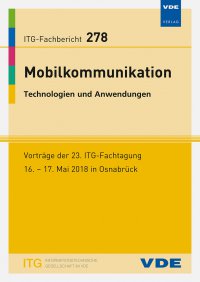Towards a Flexible Architecture for Industrial Networking
Konferenz: Mobilkommunikation – Technologien und Anwendungen - 23. ITG-Fachtagung
16.05.2018 - 17.05.2018 in Osnabrück, Deutschland
Tagungsband: Mobilkommunikation – Technologien und Anwendungen
Seiten: 6Sprache: EnglischTyp: PDF
Persönliche VDE-Mitglieder erhalten auf diesen Artikel 10% Rabatt
Autoren:
Karrenbauer, Michael; Fellan, Amina; Schotten, Hans D. (Chair for Wireless Communications and Navigation, University of Kaiserslautern, Germany)
Buhr, Henning; Seetaraman, Savita; Niebert, Norbert (Ericsson GmbH, Herzogenrath, Germany)
Ludwig, Stephan (Robert Bosch GmbH, Renningen, Germany)
Bernardy, Anne; Seelmann, Vasco; Stich, Volker (FIR e. V. at RWTH Aachen, Germany)
Hoell, Andreas; Stimming, Christian (SICK AG, Waldkirch, Germany)
Wu, Huanzhou; Wunderlich, Simon; Taghouti, Maroua; Fitzek, Frank (Deutsche Telekom Chair of Communication Networks, University of Dresden, Germany)
Pallasch, Christoph; Hoffmann, Nicolai; Herfs, Werner (Laboratory for Machine Tools and Production Engineering, RWTH Aachen, Germany)
Eberhardt, Elena; Schildknecht, Thomas (Schildknecht AG, Murr, Germany)
Inhalt:
The digitalization of manufacturing processes is expected to lead to a growing interconnection of production sites, as well as machines, tools and work pieces. In the course of this development, new use-cases arise which have challenging requirements from a communication technology point of view. In this paper we propose a communication network architecture for Industry 4.0 applications, which combines new 5G and non-cellular wireless network technologies with existing (wired) fieldbus technologies on the shop floor. This architecture includes the possibility to use private and public mobile networks together with local networking technologies to achieve a flexible setup that addresses many different industrial use cases. It is embedded into the Industrial Internet Reference Architecture and the RAMI4.0 reference architecture. The paper shows how the advancements introduced around the new 5G mobile technology can fulfill a wide range of industry requirements and thus enable new Industry 4.0 applications. Since 5G standardization is still ongoing, the proposed architecture is in a first step mainly focusing on new advanced features in the core network, but will be developed further later.


